.
Griechische Astronomie: Einige Fakten
Herodotus, the Father of History, tells us that once upon a time--which time, as the modern computator shows us, was about the year 590 B.C. --a war had risen between the Lydians and the Medes and continued five years. "In these years the Medes often discomfited the Lydians and the Lydians often discomfited the Medes (and among other things they fought a battle by night); and yet they still carried on the war with equally balanced fortitude. In the sixth year a battle took place in which it happened, when the fight had begun, that suddenly the day became night. And this change of the day Thales, the Milesian, had foretold to the Ionians, laying down as a limit this very year in which the change took place. The Lydians, however, and the Medes, when they saw that it had become night instead of day, ceased from their fighting and were much more eager, both of them, that peace should be made between them."
Henry Smith Williams, The Beginnings of Greek Science
- Thales of Miletus gained great fame by predicting an eclipse of the sun of 25th May 585 BC. Today this seems unlikely as the Astronomy as we assume at that time was not developed to be accurate enough to predict such phenomena. Some say that he was just lucky since the Chaldeans told him that every 90 years there is a eclipse of the sun but solar eclipses occur only in narrow regions on earth, unlike lunar eclipses that are visible everywhere.
- Anaxagoras observed that meteors are made of the same materials as found on Earth, even if they fall from the heavens, and then hypothesized that these were originally parts of the Earth thrown out by the rapid rotation of the Earth; as the rapid rotation of these bodies decreases they are pulled back and fall as meteors. This conclusion is, of course, wrong, but the hypothesis proposed does demonstrate imagination as well as close adherence to the observed facts. He explained the return of the sun to the east each morning by its going under the flat earth in the night. He held that in a solar eclipse the moon hides the sun, and in a lunar eclipse the moon enters the earth's shadow.
- Anaximander's opinion was that we live inside a huge sphere with fire along the outside rim, the sun is just a hole in the sphere through which we can see the fire.
- Philolaus of Croton,in southern Italy ( c. 470 - c. 385 BC ) , a Greek philosopher/scientist, contemporary of Socrates was the precursor of Copernicus in moving the earth from the center of the cosmos and making it a planet, but in Philolaus' system it does not orbit the sun but rather the central fire. Some scholars regard the astronomical system as a significant attempt to try to explain the phenomena, but others see it as primarily of mythic and religious significance. Philolaus is the first to incorporate all five planets commonly known in antiquity into an astronomical scheme in the correct order, which indicates that he was aware of the most up-to-date astronomical data. (Stanford Encyclopedia of Philosophy)
- Nicetas, Heraclides, and Ecphantes supposed the earth to revolve on its axis, but to have no orbital motion.
- Oenopides, around 450 BC, measured the inclination of the Earth axis with respect to the ecliptic plane to be 24 degrees

http://www.opencourse.info/astronomy/introduction/03.motion_earth/ Copyright 2002 Scott R. Anderson, Ph.D.
The Earth's orbit around the Sun is very nearly circular, and it defines a plane in space called the ecliptic plane. With respect to the perpendicular to the ecliptic plane (which points to orbital north), the Earth's axis is tilted at an angle of 23.5°:
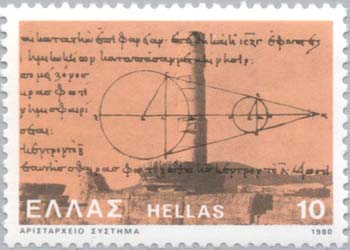
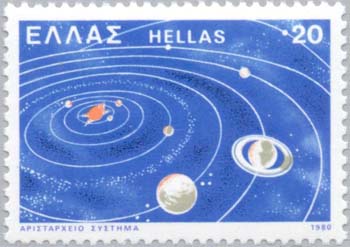
- Aristarchus of Samos (around 310-230 BC) a mathematician and astronomer was a student of Strato of Lampsacus, head of Aristotle's Lyceum. He considered the sizes and distances of the sun and the moon, and was the first to try to calculate the distances of these bodies geometrically. Furthermore, he advanced the theory that the sun was at rest at the center of the sphere of fixed stars, and that the earth and planets revolved around the sun. The apparent motion of the stars was due to the daily rotation of the earth. Copernicus was familiar with Aristarchus' theory of the universe, which at the time, however, did not find favor with the ancient philosophers. The first person we know who realized the Earth couldn't be flat was the Greek philosopher Anaximander. Around 560 BC, he suggested that the Earth had a cylindrical shape. Anaximander's Cosmos
Some think that the earth remains at rest. But Philolaus the Pythagorean believes that, like the sun and moon, it revolves around the fire in an oblique circle. Heraclides of Pontus and Ecphantus the Pythagorean make the earth move, not in a progressive motion, but like a wheel in rotation from west to east around its own center.
Plutarch, Moralia, ca. 100 ADThe counter-earth was the first part of the system to be abandoned; and it is suggested that this abandonment was due to the extension of the geographical horizon. Discoveries were made both to the east and to the west. Hanno, the Carthaginian, had made his great voyage of discovery beyond the Pillars of Hercules, and on the other (the eastern) side India became part of the known world. It would naturally be expected that, if journeys were made far enough to the east and west, points would be reached from which it should be possible to see the counter-earth, but, as neither the counter-earth nor the central fire proved in fact to be visible, this portion of the Pythagorean system had to be sacrificed, Heath
Aristotle suggests that the rotating Earth was a generally accepted tenet of Pythagorism:
While most of those who hold that the whole heaven is finite say that the earth lies at the center, the philosophers of Italy, the so-called Pythagoreans, assert the contrary. They say that in the middle there is fire, and that the earth is one of the s tars, and by its circular motion round the center produces night and day.
Aristotle, De Caelo, Fourth Century BCBut Aristarchus of Samos brought out a book consisting of certain hypotheses, in which the premises lead to the conclusion that the universe is many times greater than that now so called. His hypotheses are that the fixed stars and the sun remain motion less, that the earth revolves about the sun in the circumference of a circle, the sun lying in the middle of the orbit, and that the sphere of the fixed stars, situated about the same center as the sun, is so great that the circle in which he supposes the earth to revolve bears such a proportion to the distance of the fixed stars as the center of the sphere bears to its surface.
Archimedes, The Sand-Reckoner, Third Century BCAristarchus suggests that the sun is the center of the solar system. No one took him seriously, and his writings no longer exist. The only reason we know of him is that Archimedes (whose writings do exist) referred to Aristarchus as holding this apparently nonsensical notion. Aristarchus believed that the motions of the heavenly bodies could easily be understood if it were assumed that all of the planets, including Earth, revolved around the sun and that the stars must be infinitely far away because they seemed motionless. Copernicus knew of Aristarchus' views and mentioned them in a passage in De Revolutionibus Orbium Coelestium that he eliminated shortly before publication :-( as though not wishing to compromise his own originality.
Aristarchus introduced six hypotheses, from which he determined first the relative distances of the sun and the moon, then their relative sizes:
1) The moon receives its light from the sun.
2) The earth is positioned as a point in the center of the sphere in which the moon moves.
3) When the moon appears to us halved, the great circle which divides the dark and bright portions of the moon is in the direction of our eye.
4) When the moon appears to us halved, its [angular] distance from the sun is then less than a quadrant by one-thirtieth part of a quadrant. (One quadrant = 90 degrees, which means its angular distance is less than 90 by 1/30th of 90, or 3 degrees, and is therefore equal to 87 degrees.) (This assigned value was based on Aristarchus' observations.)
5) The breadth of the earth's shadow is that of two moons.
6) The moon subtends one fifteenth part of a sign of the Zodiac. (The 360 degrees of the celestial sphere are divided into twelve signs of the Zodiac each encompassing 30 degrees, so the moon, therefore, has an angular diameter of 2 degrees.)Although he proved many propositions (eighteen to be exact), the three most well-known are the following:
1) The distance of the sun from the earth is greater than eighteen times, but less than twenty times, the distance of the moon from the earth.
2) The diameter of the sun has the same ratio (greater than eighteen but less than twenty) to the diameter of the moon.
3) the diameter of the sun has to the diameter of the earth a ratio greater than 19 to 3, but less than 43 to 6.In his determination of these three factors, Aristarchus developed the Lunar Dichotomy method and the Eclipse Diagram, the latter of which became a much-used method of determining celestial distances up until the seventeenth century. There is some analogy with Galileo and Aristarchus. Plutarch says that Cleanthes wanted that Aristarchus should be punished because of his heliocentric model. Also Plutarch says that Aristarchus developed this model because he wanted to describe the observations that he could best with his model, or as Plutarch says to save the phaenomena ( ta phainomena sozein ). His ideas were not accepted because the measurements were not good enough to see effects like the Parallax which Hipparchus tries to observe without any success and we know now why!
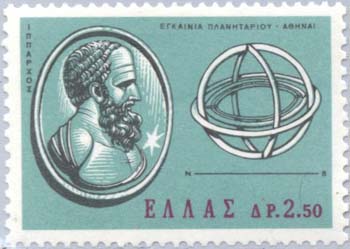
-
Hipparchus (2nd century BC), the greatest astronomer of the ancient world, is thought to have invented the astrolabe. He continued the work of Aristarchus in calculating the distance of the moon by measuring its parallax against the sphere of fixed stars. His result of 30 earth diameters is correct. From his observations he produced the first star catalogue, grading the stars by brightness. Hipparchus discovers the precession of the equinoxes. He uses observations from Egypt and Babylon more than 100 year old but probably has not a correct explanation for the precession as Voltaire describes. Hipparchus calculates the length of the year to within 6.5 minutes of the correct value. His astronomical work uses an early form of trigonometry.
-
The first Greek to observe ocean tides, in the Atlantic in the early third century B.C., was the navigator and astronomer Pytheas, who also produced the correct explanation for them. He was 2,000 years ahead of his time, for it took that long for tides to be attributed (by Newton) properly to the influence of the moon. Until Newton's time, most scholars refused to believe that the moon could have any effect on the ocean, especially because one tide each day took place when the moon was not even visible in the sky.
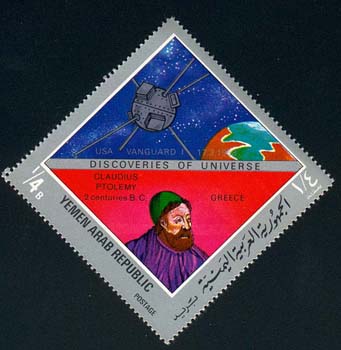
- Ptolemy codified the Greek geocentric view of the universe, and rationalized the apparent motions of the planets as they were known in his time. Ptolemy synthesized and extended Hipparchus's system of epicycles and eccentric circles to explain his geocentric theory of the solar system. Ptolemy's system involved at least 80 epicycles to explain the motions of the Sun, the Moon, and the five planets known in his time. He believed the planets and sun to orbit the Earth in the order Mercury, Venus, Sun, Mars, Jupiter, Saturn . This system became known as the Ptolemaic system. It predicts the positions of the planets accurately enough for naked-eye observations. For more details See Ptolemy the Greatest ancient Astronomer
- Not all were so enthusiastic about astronomic measurements like Anaxagoras: What is the sense of human life? he (Anaxagoras) was asked; “to look at the sky, the stars, the moon, the sun,” was his response. Iamblichus, Protrepticus 51,11 = Aristotle, Protrepticus Fr. 11 Ross, and Eudemian Ethics 1216a11 = DK 59 A 30. Plato in the Republic has a different opinion! The sparks that paint the sky, since they are decorations on a visible surface, we must regard, to be sure, as the fairest and most exact of material things; but we must recognize that they fall far short of the truth ... both in relation to one another and as vehicles of the things they carry and contain. These can be apprehended only by reason and thought, but not by sight... It is by means of problems, then, as in the study of geometry, that we will pursue astronomy too, and we will let be the things in the heavens, if we are to have a part in the true science of astronomy... Plato
However even if this sounds very esoteric Plato was very important in the development of Greek Astronomy. What he said is that geometry should be considered in solving astronomical problems. Observation alone is not enough. Eudoxus, Aristarchus, Hipparchus and Ptolemy agreed with Plato's opinion and they developed their own geometric, mathematical model of the Universe
Plutarch wrote of Plato " ... that Plato in his later years regretted that he had given the earth the middle place in the universe which was not appropriate." Plato laid out a research project for his students to find "what are the uniform and ordered movements by the assumption of which the apparent movements of the planets can be accounted for." Robert Trout, See: Heraclides of Pontus Was No Baby Boomer
Astronomy in Greek Literature
In the Odyssey, Calypso directs Odysseus, in accordance with Phoenician rules for navigating the Mediterranean, to keep the Great Bear "ever on the left as he traversed the deep" when sailing from the pillars of Hercules (Gibraltar) to Corfu. Yet such a course taken now would land the traveller in Africa. Odysseus is said in his voyage in springtime to have seen the Pleiades and Arcturus setting late, which seemed to early commentators a proof of Homer's inaccuracy. Likewise Homer, both in the Odyssey [1] (v. 272−5) and in the Iliad (xviii. 489), asserts that the Great Bear never set in those latitudes. Now it has been found that the precession of the equinoxes explains all these puzzles; shows that in springtime on the Mediterranean the Bear as just above the horizon, near the sea but not touching it, between 750 B.C. and 1000 B.C.; and fixes the date of the poems, thus confirming other evidence, and establishing Homer's character for accuracy.
[1] (In Greek!) Plaeiadas t' esoronte kai opse duonta bootaen 'Arkton th' aen kai amaxan epiklaesin kaleousin, 'Ae t' autou strephetai kai t' Oriona dokeuei, Oin d'ammoros esti loetron Okeanoio. George Forbes, History of Astronomy.
Etymology (In Preparation)
Anomalistic month from anomalia deviation, roughness
Aphelion from apo from and helios Sun
Asteroid from astron (star) and -oid (like)
Astronomy from astèr (star) and nomos law
Chromosphere from chroma color; sphaira ball
Comet from aster kometes long-haired star
Eclipse literally means abandonment
Ephemeris -from ephémeros, -on", daily. An almanac of the daily motions of the planets and stars.
Galactic from gala milk
Geocentric gaea Earth; kentron center, middle
Geographic gaea Earth; graphein description
Heliocentric from Helios Sun; kentron center, middle (Sun as its center)
Horizon, horizontal from horizon boundary
Meteor, meteorite from meteoros ( lifted up, floating in the air )
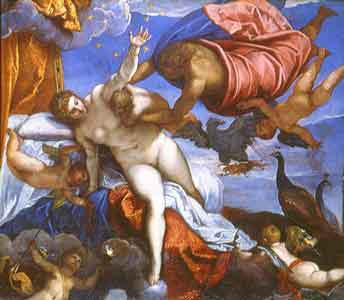
Milky way
Perihelion from peri around; helios Sun
Photosphere from photos light; sphaira ball
Planet from planetes (wanderer)
Star from astèr star
See also
a) Hipparchus the exact Astronomer , b) Hipparchus fails to measure the stellar parallax: one reason of not accepting Aristarchus model
Ptolemy the greatest ancient astronomer (even with possible data manipulations) ,
Did Hipparchus discover Newtons gravity and inverse square law? ,
Archytas “proof” of an infinite Universe , Galaxies and Extraterrestrial life: Democritus, Epicurus and others
The Total Solar Eclipse Described by Plutarch
Epicurus: Letter to Pythocles , Ancient Greeks and Craters on the Moon
Interesting Sites
An Atlas of the Universe (Views of our world at different distances (the structure of the Cosmos)
| Ancient Greece
Science, Technology , Medicine , Warfare, , Biographies , Life , Cities/Places/Maps , Arts , Literature , Philosophy ,Olympics, Mythology , History , Images Medieval Greece / Byzantine Empire Science, Technology, Arts, , Warfare , Literature, Biographies, Icons, History Modern Greece Cities, Islands, Regions, Fauna/Flora ,Biographies , History , Warfare, Science/Technology, Literature, Music , Arts , Film/Actors , Sport , Fashion --- |

